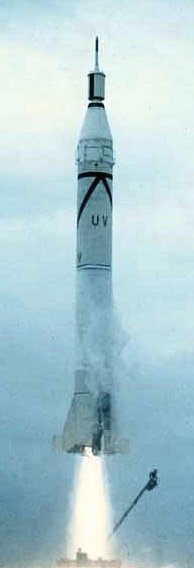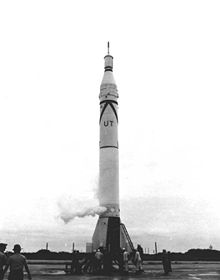Juno I
The Juno I (often incorrectly referred to as Jupiter C ) was a modification of the American Redstone rocket that was developed for the launch of the first American Explorer 1 satellite .
Basic design
The Juno I consisted of the three-stage Jupiter-C rocket developed for re-entry tests with a fourth stage attached. This was ignited after the third stage burned out and brought the payload to a speed of 29,000 km / h. This multi-stage system, originally developed by Wernher von Braun for his "Project Orbiter", did not yet have a control system for the upper stages of the rocket. After the first stage had burned out, the spin-stabilized upper stages were brought into the desired orientation and separated. The upper grades, known as the “cluster”, consisted of 11 baby sergeant solid rocket motors of the second stage arranged in a ring around the three baby sergeant motors of the third stage. The fourth stage single baby sergeant engine was on the third stage and was firmly attached to the payload. Like the Jupiter C, the Juno I was 21.2 m high.
Technical specifications
| length | 21.3 m | ||
| span | 3.66 m | ||
| diameter | 1.78 m | ||
| Takeoff mass | 31.5 t | ||
| stages | 4th | ||
| 1st stage | |||
| Engine | Rocketdyne A-7 | ||
| Start thrust | 369 kN | ||
| fuel | Hydyne and LOX | ||
| Burn time | 155 p | ||
| Takeoff / empty mass | 30.96 / 6.16 t | ||
| 2nd stage | |||
| Engine | 11 baby sergeant | ||
| thrust | 73.4 kN | ||
| fuel | TPH | ||
| Takeoff / empty mass | 327/90 kg | ||
| Burn time | 6.5 s | ||
| length | 1.3 m | ||
| diameter | 0.86 m | ||
| 3rd stage | |||
| Engine | 3 baby sergeant | ||
| thrust | 24.0 kN | ||
| fuel | TPH | ||
| Takeoff / empty mass | 94/28 kg | ||
| Burn time | 6.5 s | ||
| length | 1.3 m | ||
| diameter | 0.41 m | ||
| 4th stage | |||
| Engine | 1 baby sergeant | ||
| thrust | 8.0 kN | ||
| fuel | TPH | ||
| Takeoff / empty mass | 27/5 kg | ||
| Burn time | 6.5 s | ||
| length | 1.3 m | ||
| diameter | 0.15 m | ||
history
Despite the great success and public joy after the launch of Explorer 1, only two of the five other launches of the rocket were successful, the launches of Explorer 3 and 4. After the relative success of this program, von Braun developed the Juno II from the PGM-19 Jupiter .
The six starts of the Juno I:
- January 31, 1958: Start with Explorer 1 with a weight of 13.91 kg (8.32 kg payload), perigee 360 km, apogee 2535 km.
- March 5, 1958: Attempted launch of Explorer 2 , weighing 14.22 kg (8.54 kg payload), failed because the fourth stage did not ignite.
- March 26, 1958: Start with Explorer 3 with a weight of 14.1 kg (8.41 kg payload), perigee 192 km, apogee 2,800 km.
- July 26, 1958: Start with Explorer 4 with a weight of 16.86 kg (11.68 kg payload), perigee 262 km, apogee 2,210 km.
- August 24, 1958: Attempted launch of Explorer 5 with a weight of 16.86 kg (11.68 kg payload), failed when the second stage after separation collided with a booster.
- October 23, 1958: Attempted launch of a communications satellite from Project Echo with a weight of 14.3 kg (8.3 kg payload) failed because the second stage separated too early.
See also
Web links
- http://www.ipmsstockholm.org/magazine/2005/06/stuff_eng_davidoff_explorer.htm
- http://www.bernd-leitenberger.de/juno-vanguard.shtml
Individual evidence
- ↑ http://www.bernd-leitenberger.de/juno-vanguard.shtml , accessed on December 9, 2014
- ↑ Gunter's Space Page: [1] , accessed December 9, 2014


